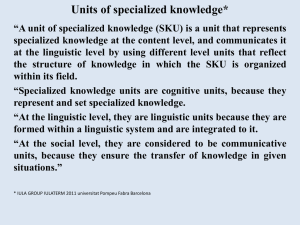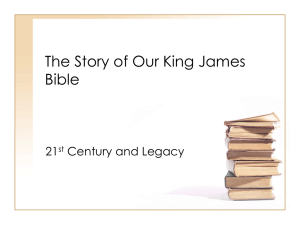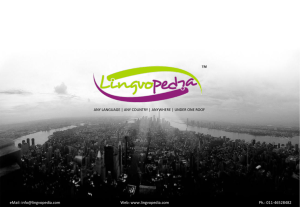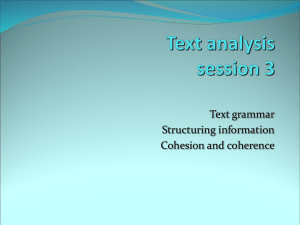LINGUA INGLESE A.A.2005-6 PROF. MARIA TERESA PRAT
advertisement
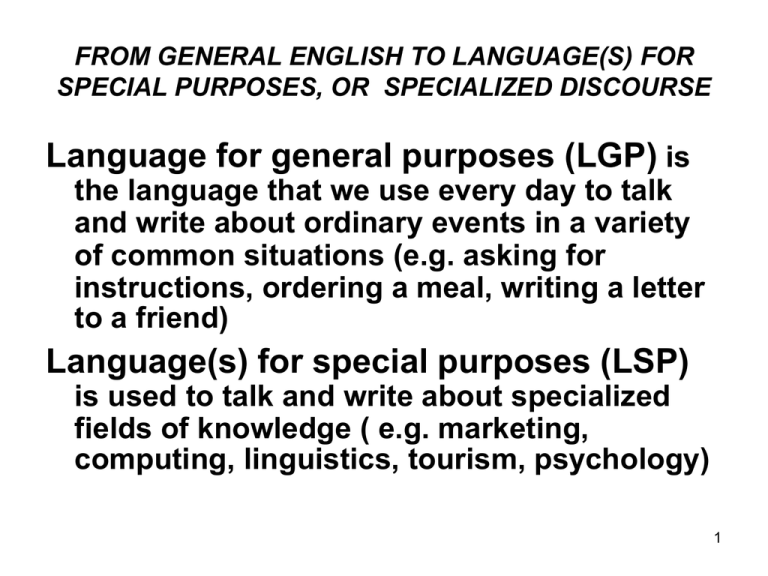
FROM GENERAL ENGLISH TO LANGUAGE(S) FOR SPECIAL PURPOSES, OR SPECIALIZED DISCOURSE Language for general purposes (LGP) is the language that we use every day to talk and write about ordinary events in a variety of common situations (e.g. asking for instructions, ordering a meal, writing a letter to a friend) Language(s) for special purposes (LSP) is used to talk and write about specialized fields of knowledge ( e.g. marketing, computing, linguistics, tourism, psychology) 1 SPECIALIZED DISCOURSE A DIACHRONIC PERSPECTIVE IN LINGUISTICS • Some major 20th century linguistic models have described language as a system (De Saussure) or as an abstract mental model (Chomsky), often not paying attention to its social and functional varieties; • 1920s and 30s: a group of linguists known as ‘The Prague School’ payed attention to the “functional style” of scientific and technical texts, often seen as ‘restricted’ and ‘inferior’ to literary language or language for general purposes; • After the Second World War: stress on the linguistic features that diverge from the ‘default’ level of general language 2 SINCE THE 1960s THERE HAS BEEN GROWING ATTENTION … • to the study of variation according to the USER (geographical and social) and to USE (who speaks/writes to whom, about what and through what medium, M.A.K. Halliday’s “tenor”, “field”, “mode”). A language consists of different registers that realize its “potential” in different ways • from focus on “terminology” to the morpho-syntactic, textual and contextual levels, from a “microlinguistic” to a “macrolinguistic” approach; terminological proliferation, e.g. ESP, ESL, ESD, microlanguages, special languages, specialized discourse, language of the professions, legal English, business English, English for tourism… • Development of corpus-based methodology, which allows the study of authentic texts in electronic form 3 The Italian tradition in the study of specialized discourse • DIFFERENT LABELS e.g.linguaggi settoriali, microlingue, sottocodici, lingue speciali, linguaggi specialisti, le lingue delle professioni) • CERLIS (Centro di Ricerca sui Linguaggi Specialistici), Universita’ di Bergamo http://www.unibg.it/cerlis/home.htm 4 The complexity of specialized discourse • HORIZONTAL DIMENSION: DIFFERENT FIELDS, OR DOMAINS, AND SUB-FIELDS (e.g. business, economics, new economy, finance, marketing, e-commerce, franchising) • VERTICAL DIMENSION: a) specialist to specialist (exposition) b) specialist to specialist-to-be (instruction) c) specialist to layperson (journalism) 5 Specialized discourse What parts/features appear to be typical of specialized discourse and make its comprehension and translation difficult ? 6 LEXICAL CHARACTERISTICS • SPECIALIZED TERMS (simple or compound) referring to precise scientific concepts e.g. behaviour, chronic, psychoactive, addiction… • COLLOCATIONS REFERRING TO ACADEMIC RESEARCH. e.g. estimates vary, factors explain, …show evidence, …apply criteria, classify; • LACK OF EMOTION e.g. the words “risk”, “threatened” and are used in a technical/descriptive sense; • REPETITION OF TERMS • PRECISION is favoured over lexical richness • CONCISENESS • LEARNED WORDS OF CLASSICAL ORIGIN: criteria, phenomenon… 7 SYNTACTIC CHARACTERISTICS • PREMODIFIED NOUN PHRASES “a small car-factory”; “a small-car factory” • SIMPLE SENTENCE STRUCTURE. Out of 9 sentences, only 3 of them have finite subordinate clauses • USE OF VERB TENSES: frequent use of the simple present tense, few present perfect forms, several non-finite verb forms, both ing-forms and past participle • FREQUENT USE OF PASSIVE AND INANIMATE SUBJECTS e.g. “languages have been classified” , “the factors … do not explain”. There is only one first person verb form “ here I show” to highlight the author’s voice 8 TEXTUAL FEATURES TEXT GENRE: it is the introduction to a fairly specialized contribution (the subgenre of “letter”) published in the authoritative scientific journal Nature. EXPERT-TO-EXPERT COHESION is obtained through LEXICAL REPETITION more than through anaphoric reference, use of GENERAL WORDS (criteria, factors) and FEW CONJUNCTIONS (also, however, for example) TEXTUAL STRUCTURE: The text establishes the field of investigation and the key research questions. It is both informative and argumentative. - Sentence 1 : general statement - Sentence 2 : identifying a niche for research - Sentence 3/4: acknowledging difficulties and giving an example - Sentence 5: making the research claim explicit - Sentences 6-9 expanding on the research The text is CONCISE AND SKILFULLY BUILT 9 Lexical features of specialized discourse • MONOREFERENTIALITY and PRECISION • OBJECTIVITY and LACK OF EMOTION • TRANSPARENCY, STANDARDISATION, TERMS OF CLASSICAL ORIGIN • CONCISENESS • LEXICAL PRODUCTIVITY, e.g. computing e.g. mouse, emotycon, netiquette 10 …and some exceptions • SEMANTIC INSTABILITY e.g. “noun phrase/noun group/syntagm” • Use of METAPHORS and IDIOMATIC EXPRESSIONS e.g. “bulls” “bears”/ a sperm bank / spam/ to launch a hostile bid • CLASSIC versus GERMANIC SYNONYMS, e.g. ‘thoracic’ versus ‘chest’ • REDUNDANCY in legal language e.g. “last will an testament” • CONSERVATISM e.g. “henceforth” in legal language 11 Some frequent syntactic phenomena in specialized discourse • PREMODIFICATION (e.g. “a water-cooled engine/ the inflation growth rate/ a small car factory”) • NOMINALIZATION (e.g. “A day and night weather observation station = a station in which people observe the weather both by day and by night)) • LEXICAL DENSITY (e.g. high percentage of content words versus function words in a text) • Relatively SIMPLE SENTENCE STRUCTURE e.g. fewer subordinate clauses/more non-finite clauses “ The proton is the opposite of the electron, being a particle of positive electricity”. Longer and more complex structure in legal English • USE OF VERB TENSES AND MODALITY, linked to the type of text, higher number of non-finite forms • Use of PASSIVE FORMS and DEPERSONALISATION e.g. “This hypothesis is confirmed by….” “ Rare languages are more likely…” 12 TEXTUAL GENRE A relatively stable form of communication that answers a specific function and is recognised within a discourse community at a given period of time e.g. A business letter, a business e-mail, a fax, an executive summary, a first degree or second degree dissertation, an abstract, a press release, an editorial, a death notice, an ad, a tourist brochure, a booking form 13 Translating texts ( or “dire quasi la stessa cosa” as U. Eco says) • Is translation still needed, since English has become the “lingua franca” of the world? • What is the difference between the translation of literary texts and specialized texts? • What are the “elements” in the process of translation? • What are the best translation strategies? • What makes a translation “good”? • What are the most important types of competence and knowledge a translator should have, and the resources he/she should be familiar with? 14 Types of translation in the world (according to Nida 1997) 1% literature 30% institutional/international organizations 50% industrial and business fields 19% general, newspapers and essays Dubbing and subtitling are not considered 15 The translation of literary versus specialized texts Completely different activities or the two ends of a continuum? Literary texts: more “open” texts; translators can/have to be more creative but cannot “rewrite” the text and may have to deal with specialized language; Specialized texts : more “closed” texts but also including highly sophisticated and rich linguistic choices; translators should be “faithful” but also “localize”, that is “adapt” to the target audience 16 What are the elements in the process of translation The source text The author’s intention/context The translator The target audience The purchaser’s needs 17 Translation of different text types, or genres According to the domain (e.g. legal, economic, medical) According to the author’s intention ( expressive, informative, vocative) or prevailing function (descriptive, narrative, expository, argumentative, and instructive) According to different genres, e.i. socially recognised text types 18 CORRESPONDING TEXTS IN THE TARGET CULTURE 1. 2. EQUAL (e.g. the European legislation) PARALLEL ( e.g. a contract) 3. WITH THE SAME FUNCTION (e.g. university handbook) may be similar or culturally conditioned 1. DERIVED , e.g. summaries or abstract 2. AUTONOMOUS, e.g. an ad that is adapted to a different culture but Texts can either be adapted to the target culture and “localized” ( e.g. advertising and computing software) , or follow international models ( e.g. hard sciences) 19 What are the best translation strategies in specialized discourse ? 1. Reading: from global to intensive to a reading geared to the awareness of translation difficulties at a both sociocultural and linguistic level. Contrastive awareness of Source Language versus Target Language (e.g. false friends, different word order, cultural and conceptual differences) 2. Translation: several drafts, from literal to idiomatic. Use of different types of paraphrase. Awareness of options. 3. Revision and final version 20 Some English-Italian differences which require adaptation strategies (Scarpa, pp. 120-165) 1. 2. 3. 4. English specialized texts are more reader-oriented than Italian texts, e.g. more informal and redundant English scientific and technical texts tend to be simpler and more direct than their Italian counterparts, e.g. computing style English specialized texts favour lexical reiteration rather than a variety of lexical and grammatical patterns English specialized texts use fewer connectors than Italian texts 21 Some English-Italian adaptation micro-strategies 5) From left-dislocation in English to right-dislocation in Italian , e.g. a slow-growing industry = un settore industriale in lenta crescita 6) More verbal forms in English than in Italian e.g. Opening a document= apertura di un documento 7) From simple clauses to coordination and subordination 8) English passive and impersonal forms in English can also be rendered in Italian with “si passivante” e.g. Additional information can be obtained = Si possono ottenere ulteriori informazioni 9) Retention of anglicisms in Italian, e.g. scanner, non-profit organizations, RAM, turnover 10) Calques; e.g. randomizzare 22 What are the types of competence a translator needs? • Linguistic/cultural competence in the source language and in the target language • General cultural competence • Competence in specialized domains (e.g. a specialist who is also a translator or a translator who is also a specialist?) 23 What are the resources for a specialized translator? • • • • • The Internet !!? General and specialized dictionaries and glossaries (monolingual and bilingual) Encyclopaedias and expert literature Terminological data banks Software for machine-aided human translation e.g. Trados Specialized monolingual and bilingual corpora 24 TEXT 2 (see Dossier) “Putting the boot in “ From The Economist, 25h February 2006 In the Section entitled “The World This Week”. A selection of political and business news in brief 25



